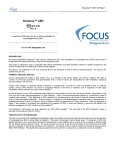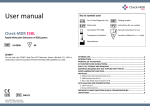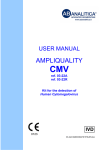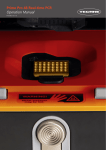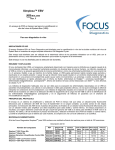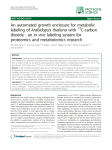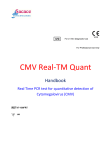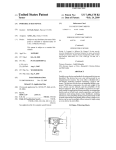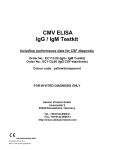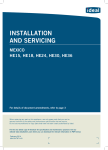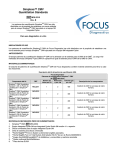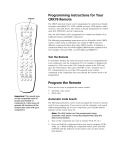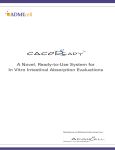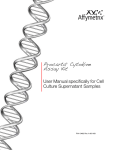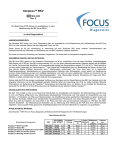Download Simplexa™ CMV - Southern Cross Diagnostics
Transcript
Simplexa™ CMV
REF MOL2200
Rev. B
A real-time PCR assay for the in vitro quantitation of
Cytomegalovirus (CMV).
For in vitro diagnostic use
INTENDED USE
The Focus Diagnostics Simplexa™ CMV assay is intended for the in vitro quantitation of cytomegalovirus (CMV) nucleic acids in
whole blood and plasma specimens using the 3M Integrated Cycler.
This assay is intended for use in conjunction with clinical presentation and other laboratory markers of disease progress for the
clinical management and monitoring of CMV-infected patients.
The assay is not intended for use as a screening test for the presence of CMV in blood or blood products. The assay is for
professional use only.
SUMMARY AND EXPLANATION
1
Human cytomegalovirus (CMV), a beta herpes virus, is a member of the human herpes virus family. Infection with CMV is
common in all human populations and approximately 70% or more of adults are seropositive for CMV antibodies, indicating
previous infection with the virus.
Primary CMV infection in otherwise healthy individuals is asymptomatic or results in a mild, non-specific illness. In pregnant
women, primary CMV infection can result in congenital infection of the fetus or newborn, and in recipients of solid organ
transplants, primary infection can cause severe disease.2, 3
As with all herpes viruses, CMV establishes latent infection in the host after recovery from the acute infection. Reactivation of the
virus can occur after immunosuppression or other illnesses. CMV in immunocompromised patients is a well-known cause of
morbidity and mortality4. Early diagnosis of CMV replication by measurement of virus levels in high-risk patients is essential in
order to start preemptive treatments. Antiviral therapy or changes to immunosuppression regimens may be indicated when a
predetermined level of virus is reached in blood or plasma before the appearance of clinical symptoms. Once the diagnosis is
made, a test capable of monitoring and quantifying the presence of CMV in blood and plasma is critical for the efficient and
5, 6
effective management of CMV infection in these patients.
The Simplexa™ CMV assay has been aligned to the CMV WHO standard7. The reported viral load of the CMV Simplexa™ assay
in copies/mL is equal to the CMV WHO standard in IU/mL.
PRINCIPLES OF THE PROCEDURE
The test is a real-time PCR amplification and detection system that utilizes a bi-functional fluorescent probe-primer for the detection
of Cytomegalovirus DNA in whole blood and plasma. The assay is composed of two principal steps: (1) extraction of DNA from
patient specimens, (2) a bi-functional fluorescent probe-primer is used together with a reverse primer to amplify a specific target
(for the analyte and the internal control). The assay provides one result; a well conserved region of the UL83 gene of the CMV
genome is targeted to identify the viral DNA in the specimen. An internal control is used to monitor the extraction process and to
detect PCR inhibition. The amplification signal obtained for each specimen is compared to a calibration curve and quantified.
Simplexa™ CMV Page 2
MATERIALS PROVIDED
TM
The Focus Diagnostics Simplexa
CMV kit contains sufficient reagents for 100 reactions.
Kit Description
Component Name
Simplexa™ CMV Primer Mix
Simplexa™ Master Mix
Simplexa™ Extraction & Amplification Control
DNA
Simplexa™ CMV Low Positive Control
Simplexa™ CMV High Positive Control
REF
EC SYMBOL
Abbreviated
ON LABEL
Name
MOL2201
REAG
A
PM
MOL2000
REAG
B
MM
MOL9001 CONTROL IC
IC
Cap
Color
Brown
Green
Blue
MOL2202 CONTROL
MOL2203 CONTROL
White
Red
+
++
LPC
HPC
Number Reactions Volume
of Vials per Vial/Kit per Vial
2
50/100
50 µL
2
50/100
200 µL
3
50/150
250 µL
6
6
1/6
1/6
200 µL
200 µL
Component Description
Component
Description
Dye-labeled fluorescent primers specific for quantitation of CMV, and for the Internal
Control.
Probe
Fluorophore
(Dye)
Excitation
Emission
Targeted Gene
CMV
FAM
495 nm
520 nm
UL83 gene
Internal Control
Q670
644 nm
670 nm
A. thaliana gene
Target
Simplexa™ CMV Primer Mix (PM)
Simplexa™ Master Mix (MM)
Simplexa™ Extraction & Amplification Control DNA
(IC)
DNA polymerase, buffer and dNTPs
A 577 base pair DNA fragment derived from the gene encoding ribulose-1,5bisphosphate carboxylase oxygenase large unit N-methyltransferase of the plant
Arabidopsis thaliana.
Simplexa™ CMV Low Positive Control (LPC)
Simplexa™ CMV High Positive Control (HPC)
Simplexa™ CMV Barcode Card
Inactivated CMV in human base matrix.
Inactivated CMV in human base matrix.
Assay specific parameters.
MATERIALS REQUIRED BUT NOT SUPPLIED
1.
2.
3.
4.
5.
6.
7.
8.
9.
10.
11.
12.
13.
14.
15.
16.
17.
18.
19.
20.
a
b
Simplexa™ CMV Quantitation Standards REF MOL2210
3M Integrated Cycler with Integrated Cycler Studio version 4.1 or higher
Universal Discs for use on the Integrated Cycler
Universal Disc Cover Tape
a
Roche MagNA Pure LC System and associated consumables.
a
Roche MagNA Pure LC Total Nucleic Acid Isolation Kit (Roche Cat. No 03038505001)
b
bioMérieux NucliSENS® easyMAG™ instrument and associated consumables and reagents
b
Biohit/ bioMérieux multi-channel pipette
b
ELISA strip plate
Single, multi-channel and/or repeater micropipette(s) with an accuracy range between 1-10 µL, 10-100 µL and 100-1000 µL
Freezer (manual defrost) at -10 to -30 °C (for kit component frozen storage)
Refrigerator at 2 to 8 °C (for specimens and thawed kit components)
Biosafety cabinet (laminar flow hood) for extractions
Microcentrifuge
Vortex mixer
Sterile, RNase/DNase-free disposable aerosol-barrier micropipettor tips
1.5 mL polypropylene microcentrifuge tubes and racks (RNase/DNase-free tubes are recommended but not required)
Disposable, powder-free gloves
Nuclease-Free Water (Used during extraction and as the No-Template Control (NTC))
Cooler racks for 1.5 mL microcentrifuge tubes
For use with Roche MagNA Pure LC extraction method
For use with bioMerieux easyMAG extraction method
SHELF LIFE AND HANDLING
1.
2.
3.
4.
5.
Store reagents at -10 to -30 °C (do not use a frost-free freezer).
Allow reagents to thaw at room temperature (approximate range 18 to 25 °C) before use.
Do not use kits or reagents beyond their expiration dates.
Use the Reaction Mix within one hour of preparation. Store Reaction Mix at 2 to 8 °C until ready to proceed with PCR Setup.
Once thawed, store the Primer Mix, Master Mix, and Extraction & Amplification Control DNA at 2 to 8 °C for no more than 30
days.
Simplexa™ CMV Page 3
6.
7.
Do not refreeze Primer Mix, Master Mix, Extraction & Amplification Control DNA or Positive Controls.
Do not combine reagents from different kit lots.
WARNINGS AND PRECAUTIONS
1.
2.
3.
4.
5.
6.
7.
8.
9.
10.
11.
12.
13.
14.
15.
16.
17.
18.
19.
20.
For in vitro diagnostic.
All human origin materials should be treated as potentially infectious. Source materials from which this product (including
controls) have been screened for Hepatitis B surface antigen, Hepatitis C antibody and HIV-1/2 (AIDS) antibody by FDAapproved methods and found to be negative. However, as no known test methods can offer 100% assurance that products
derived from human blood will not transmit these or other infectious agents, all controls, serum specimens and equipment
coming into contact with these specimens should be considered potentially infectious and should be decontaminated or
disposed of with proper biohazard precautions. CDC and the National Institutes of Health recommend that potentially
8, 9
infectious agents be handled at the Biosafety Level 2.
Wear personal protective equipment, such as (but not limited to) gloves and lab coats when handling kit reagents. Wash
hands thoroughly when finished performing the test.
Do not pipette by mouth.
Do not smoke, drink, eat, handle contact lenses or apply make-up in areas where kit reagents and/or human specimens are
being used.
Dispose of unused kit reagents and human specimens according to local, state and federal regulations.
Workflow in the laboratory should proceed in a uni-directional manner, beginning in the Pre-Amplification areas and moving to
the Amplification/Detection area: below is the sequence of events that takes place from specimen extraction to Real-Time
PCR amplification:
• Begin with specimen extraction, followed by Real-Time PCR instrument set-up, reagent preparation, and finally Real-Time
PCR amplification.
• No cross-movement of supplies or equipment is recommended between the different areas.
• Supplies and equipment used for specimen preparation should not be used for reagent preparation activities or for
processing amplified DNA or other sources of target nucleic acid.
• All amplification supplies and equipment should be kept in the Real Time PCR Instrument Area at all times.
• Personal Protective Equipment, such as laboratory coats and disposable gloves, should be area-specific.
Contamination of patient specimens or reagents can produce erroneous results. Use aseptic techniques.
Pipette and handle reagents carefully to avoid mixing of specimens from adjacent wells.
Use proper pipetting techniques and maintain the same pipetting pattern throughout the procedure to ensure optimal and
reproducible values.
Do not substitute or mix reagent from different kit lots or from other manufacturers.
Do not interchange the reagent tube caps. This may cause contamination and compromise the test results.
Only use the protocol described in this insert. Deviations from the protocol or the use of times or temperatures other than
those specified may give erroneous results.
Assay setup should be performed at room temperature (approximate range 18 to 25 °C). While mixing the reagents, keep the
enzymes cold by utilizing a cooler block.
Do not re-use Universal Discs that have already been exposed to patient specimens or reagents.
Dispose of used disc without detaching the cover tape.
™
If different Simplexa kits or lots are set up on the same disc, Positive and No Template Controls from each kit need to be
tested.
Master Mix contains > 1% glycerol, which may cause irritation upon inhalation or skin contact. Upon inhalation or skin
contact, first aid measures should be taken.. Observe the general safety regulations when handling chemicals. This product
is not subject to identification regulations according to the directives on hazardous materials.
Extended storage of extracted specimens at 2 to 8 °C is not recommended; performance has not been established.
If kit packaging or contents appear to be broken or damaged do not use and contact Focus Diagnostics. Contact information
is on the last page of this document.
INSTRUCTIONS FOR USE
A.
SPECIMEN COLLECTION
The acceptable specimen types are whole blood or plasma collected by venipuncture. Do not use collection tubes with
heparin as an anticoagulant. Heparin inhibits PCR.
B.
SPECIMEN EXTRACTION AREA
Perform in a dedicated area for specimen and control extraction. Specimen preparation for extraction should be performed in
a biosafety cabinet.
Extraction using Roche MagNA Pure LC extraction method
1. Extract patient specimens and assay controls using the Roche MagNA Pure Total Nucleic Acid Isolation Kit and the
Roche MagNA Pure LC Automated Nucleic Acid Extractor instrument. Refer to the manufacturer’s Instructions for Use
for nucleic acid extraction using this kit.
2. Under the “Protocol” drop-down menu on the MagNA Pure LC System, select “Total NA”, and then “Total NA
Variable_elution_volume.blk” from the list. This will load the appropriate settings for the run.
3. The Sample Protocol should be “Total NA Variable_elution_volume”.
Simplexa™ CMV Page 4
4.
5.
6.
7.
8.
9.
10.
11.
200 µL should be set for the Sample Volume, and the elution volume should be set at 50 µL.
The dilution volume should be set at zero for all specimens.
Ensure that the Post Elution Protocol is set to “None”.
Ensure that specimens and controls are in the correct position on the Sample Cartridge.
Vortex each specimen, LPC and HPC for 2 to 4 seconds and briefly centrifuge to pull contents down to bottom of tube.
Pipette 200 µL of each specimen, LPC, HPC and NTC into the corresponding position in the sample cartridge.
Visually check the level of specimen and controls in the Sample Cartridge to ensure specimen(s) were added.
Pulse vortex Extraction & Amplification Control DNA (IC) 2 times and briefly centrifuge to pull contents down to bottom of
tube.
12. For each set of 16 specimens (1-16 specimens), pipette 100 µL of the (IC) into 6 mL lysis buffer in a conical tube. Mix by
vortexing briefly. Add to the appropriate tray on the MagNA Pure extraction instrument.
o For example, if greater than 16 specimens (17-32 specimens) are extracted, Pipette 200 µL of the IC into 12mL lysis
buffer in a conical tube. Mix by vortexing briefly. Add to the appropriate tray on the MagNA Pure extraction
instrument.
13. Transfer the sample cartridge to the MagNA Pure LC Automated Nucleic Acid extractor and begin the extraction run.
14. After nucleic acid extraction is complete, the cartridge containing the extracted controls and patient specimens can be
removed from the MagNA Pure and sealed. Store the extracted DNA at 2 to 8 °C prior to use. Long-term storage of
extracted specimens at this temperature is not recommended. Keep extracted DNA specimens on a cooler block while
loading disc.
Extraction using bioMérieux NucliSENS® easyMAG™ extraction method
1.
2.
®
Refer to the NucliSENS easyMAG™ User Manual for operation of the instrument and software.
®
Choose the Generic template on the NucliSENS easyMAG™ software with the following settings;
Default Request:
Generic 2.0.1 (or equivalent)
Run Name Prefix:
(as appropriate)
Sample ID prefix:
(as appropriate)
Sample Type:
Primary
Workflow Defaults:
On-board lysis Incubation
On-board Silica Incubation
Sample Addition Guidance Off
Reagent Tracking:
Lysis, Silica, Internal Control reagent tracking disabled
3.
Enter individual specimen information into Extraction Request screen as below.
Sample ID:
(Enter sample name)
Request:
Generic 2.0.1 (or equivalent)
Volume (mL):
0.200
Eluate (µL):
50
Type:
Primary
Priority:
Normal
Matrix:
Other
4.
5.
6.
7.
8.
9.
10.
11.
®
Create Extraction Run in NucliSENS easyMAG™ software per User Manual.
Vortex each specimen, LPC and HPC for 2 to 4 seconds and briefly centrifuge to pull contents down to bottom of tube.
Pipette 200µL of specimen, LPC, HPC or NTC to sample vessel(s).
Pulse vortex IC two (2) times and briefly centrifuge to pull contents down to bottom of tube.
Pipette 5µL of IC to each specimen and all control wells. Change tips in between specimens.
Load sample vessel(s), new aspirator disposables, and reagents onto the easyMAG™ instrument per User Manual.
Initiate the on-board lysis and incubate the lysed specimens for 10 minutes before addition of magnetic silica mixture.
During lysis incubation period, prepare magnetic silica mixture. Mix silica and dilute in nuclease-free water by adding 1
part magnetic silica to 3 parts nuclease-free water (e.g., 270µL of magnetic silica + 810µL nuclease-free water). Prepare
minimally 135µL of magnetic silica mixture per specimen.
To transfer silica mixture into ELISA strip wells, mix magnetic silica mixture and use 1 tip and operating mode P2 of the
Biohit pipette. Press Start to aspirate 1050µL of the magnetic silica mixture and press Start again to dispense the first
shot back into silica mixture tube. Press Start to dispense 125µL of the magnetic silica mixture into 8 individual wells of
the ELISA strip. Repeat as necessary for additional ELISA strips.
After the 10 minute lysis incubation, use 8 tips (per ELISA strip) and operating mode P3 of the Biohit pipette to transfer
100µL of magnetic silica mixture to each specimen in the sample vessel. Place tips into the ELISA strip wells and press
Start to mix and aspirate magnetic silica mixture.
Transfer magnetic silica mixture to appropriate sample vessel and place pipette tip(s) into specimens below the liquid
level. Press Start to aspirate, dispense and mix (x3) the magnetic silica and specimens. Ensure pipette tips remain
below the liquid level to ensure proper mixing.
Repeat steps 13 and 14 for additional sample vessels.
After addition of magnetic silica mixture to all sample vessels, start the extraction run.
12.
13.
14.
15.
16.
Simplexa™ CMV Page 5
17. Upon completion of run, remove sample vessel(s) from the instrument. If specimens are not going to be used
immediately, transfer into individual tubes to minimize chance of magnetic silica falling back into specimen. Store the
extracted DNA at 2 to 8ºC prior to use. Long-term storage of extracted specimens at this temperature is not
recommended. Keep extracted DNA on a cooler block while loading disc.
C.
REAL-TIME PCR INSTRUMENT SETUP
1.
Refer to Integrated Cycler Operator Manual for details on how to configure the Integrated Cycler Studio Software to add
an assay definition, set up runs and analyze runs on the Integrated Cycler.
Note: A valid standard curve (calibration run) must be established prior to performing a prediction run.
D.
REAGENT PREPARATION AREA
Dedicated area for preparation of SimplexaTM CMV assay reaction mix.
1. Thaw the Primer Mix and the Master Mix at room temperature (approximate range 18 to 25 °C). Each kit component vial
contains sufficient reagents for 50 reactions. Prior to each use, gently mix the Primer Mix and Master Mix kit components
and briefly centrifuge to pull contents down to bottom of tube.
2. Prepare the required volume of the Reaction Mix in an appropriately sized polypropylene microcentrifuge tube by
pipetting the volume of each component as indicated in the table below.
Reaction Mix Volumes
Reaction Mix
Reaction Mix
Volume / 1 reaction
Volume / 10 reactions
Simplexa™ Master Mix
4.0 µL
40 µL
Simplexa™ CMV Primer Mix
1.0 µL
10 µL
Total Volume
5.0 µL
50 µL
Gently mix the Reaction Mix by pipetting 8 to 10 times.
Briefly centrifuge to pull contents down to bottom of tube.
Proceed to PCR setup.
Use the Reaction Mix within one hour of preparation. Store Reaction Mix at 2 to 8 °C if PCR setup will not be performed
immediately after the Reaction Mix is prepared.
Reagent
3.
4.
5.
6.
E.
REAL TIME PCR AMPLIFICATION AREA
Perform in a dedicated area for preparation of the 96-well Universal Disc for the Simplexa™ CMV assay.
1. Add 5.0 µL of the Reaction Mix to each well.
2. Add 5.0 µL of the extracted Positive Controls to the “HPC and LPC” wells.
3. Add 5.0 µL of extracted patient specimen to the appropriate “S” well.
4. Add 5.0 µL of extracted No-Template Control to the “NTC” well.
5. Cover the disc with the Universal Disc Cover Tape.
6. Open the lid of the Integrated Cycler.
7. Place the sealed Universal Disc onto the platen.
8. Close the lid gently.
9. Click Run.
10. Click Start.
F.
DATA ANALYSIS
1. Refer to Integrated Cycler Operator Manual for details on how to perform data analysis and how to export runs if needed.
QUALITY CONTROL
Each laboratory should establish its own Quality Control ranges and frequency of QC testing based on applicable local laws,
regulations and standard good laboratory practice.
REPORTING RESULTS
1.
Run Validity
Determine if the run is valid by reviewing the CMV and Internal Control (IC) results for the Low Positive Control (LPC),
High Positive Control (HPC), and No-Template Control (NTC). All three controls must meet acceptance criteria for a run
to be valid. If a run is invalid, then all patient specimens must be re-tested.
Control
No-Template Control (NTC)
Low Positive Control (LPC)
High Positive Control (HPC)
•
Acceptance Criteria
CMV
Not Detected
Within tolerance value on lot specific label
Within tolerance value on lot specific label
Extraction & Amplification Control DNA (IC)
Detected
Not Applicable
Not Applicable
The NTC meets the acceptance criteria if CMV is Not Detected and the IC is Detected. Detecting CMV in the NTC
indicates that samples may have been contaminated during processing.
Simplexa™ CMV Page 6
2.
•
The LPC meets the acceptance criteria if CMV is Detected in the LPC within the tolerance limits (as indicated on the
lot specific label), and the IC should be Detected, but is not required to be Detected.
•
The HPC meets the acceptance criteria if CMV is detected in the HPC within the tolerance limits (as indicated on the
lot specific label), and the IC should be Detected, but is not required to be Detected.
Interpretation of Results
Interpretation of Results
Example
1
2
3
4
5
3.
CMV value
Not Detected
< 713
X copies/mL
> 3.96 × 108 copies/mL
Not Detected
IC value*
Detected
N/A
N/A
N/A
Not Detected
Interpretation
CMV Not Detected
CMV Detected, below the LLoQ (Lower Limit of Quantitation).
CMV Detected at specific concentration.
CMV Detected above the ULoQ (Upper Limit of Quantitation).
Invalid, re-extract and repeat.
Specimen Result Validity
A specimen is valid if either
1.
CMV is Not Detected and the IC is Detected.
2.
CMV is Detected. The IC does not need to be detected for CMV positive results.
3.
Amplification curves shall be reviewed for every result, especially when a “Data Quality” message is reported. A
valid amplification curve shows a smooth, exponential increase. Refer to the operator manual for recommended
actions.
LIMITATIONS
For In-vitro Diagnostic Use Only
Analysts should be trained and familiar with testing procedures and interpretation of results prior to performing the assay.
The 3M Integrated Cycler Studio retains the last valid calibration file to quantify unknown patient specimens. The
Quantitation Standards and the patient specimens must be extracted using the same extraction methodology or you may
receive erroneous results.
4. When monitoring a patient the same extraction method must be used in all determinations or results may not be relative.
5. All results from this and other tests should be correlated with the clinical history, epidemiological data and other data available
to the clinician evaluating the patient.
6. The prevalence of infection will affect the test’s predictive value.
7. As with other tests, negative results do not rule out CMV infection.
8. False-negative results may occur if the infecting organism has novel genomic mutations, insertions, deletions, or
rearrangements.
9. False-negative results may occur if inadequate numbers of organisms are present in the specimen due to low viral loads,
early in the course of illness or improper collection, transport or handling.
10. As with other tests, false-positive results may occur. Repeat testing or testing with a different device may be indicated in
some settings.
11. The performance of this test has not been established for screening of blood or blood products for the presence of CMV.
12. This test cannot rule out diseases caused by other bacterial or viral pathogens.
1.
2.
3.
Simplexa™ CMV Page 7
PERFORMANCE CHARACTERISTICS
METHOD COMPARISON
Comparison with a CE marked predicate device was performed using Passing-Bablok linear regression analysis over the linearity
range of both the assays. The linear regression parameters (slope & intercept) with 95% confidence interval were calculated using
Passing-Bablok method.
Simplexa™ CMV Page 8
REPRODUCIBILITY
Reproducibility studies were conducted used a panel that consisted of contrived plasma and whole blood samples spiked with
varying concentrations of a CMV strain. The panel contained a set of negative (unspiked matrix), low positive (approximately 2 to
4 times LOD), medium positive (approximately 8 to 10 times LOD) and high positive (near upper range of the assay) samples for
each matrix. In addition, each calibrator level, from a single lot of CMV Quantitation Standard (QS) set (n=5) was included in the
panel to be tested as ‘unknowns’.
The sample panel (n=13), included Low Positive Control (LPC), High Positive Control (HPC) and a No Template Control (NTC)
and was extracted once per day per operator with the MagNA Pure LC instrumentation, using MagNA Pure Total Nucleic Acid
Isolation kit, and with NucliSENS easyMAG™ system using the relevant reagents. The panel of extracted DNA was then assayed
in quadruplicate using the Integrated Cycler instrument. Results are in the table below.
Simplexa™ CMV Page 9
The NTC, negative plasma, negative whole blood and one quantitation standard were run as part of the reproducibility panel and
all were reproducible but out of the reportable range of the assay and hence not included into quantitative reproducibility.
ANALYTICAL SENSITIVITY/LIMIT OF DETECTION
The LoD samples used for this study were contrived from a strain of quantified CMV stock spiked into clinical negative plasma
and whole blood matrices. The panel included a negative (unspiked matrix) and varying concentrations of CMV near the
expected LoD as determined in verification testing.
The study consisted of multiple runs to evaluate the LoD of the Investigational Simplexa™ CMV kit using two extraction methods.
To determine the LoD, 3 distinct extractions and PCR runs were performed. Each extracted sample was assayed in octuplet (one
extraction, 8 wells) along with assay controls (singlicate). Overall, each member of the panel was tested in a total of 24 replicates.
The lowest concentration that gave ≥ 95% detection rate based on Probit analysis is the LoD. The LoD was determined to be 711
Copies/mL.
LINEARITY
The Linearity was determined using samples contrived from a strain of quantified CMV stock spiked into clinical negative plasma
and whole blood matrices. The panel consisted of at least 10 pools of known copies, across the expected linear range. Of the
pools, at least 3 concentrations were near the Lower Limit of Quantitation (LLOQ), 2 near the Upper Limit of Quantitation (ULOQ)
and the remaining pools approximately distributed approximately evenly between the LLOQ and ULOQ. Each sample was
assayed randomly, in at least 3 replicates.
Simplexa™ CMV Page 10
Linearity Plot for Plasma with easyMAG Extraction
Linearity Plot for Whole Blood with easyMAG Extraction
Simplexa™ CMV Page 11
Linearity Plot for Plasma with MagNA Pure Extraction
Linearity Plot for Whole blood with MagNA Pure Extraction
Simplexa™ CMV Page 12
REPORTABLE RANGE
The reportable range of the assay was determined as > 713 copies/mL to < 3.96 × 108 copies/mL. Samples greater than the
8
linear range will be reported as > 3.96 × 10 copies/mL and samples below 713 will be reported as <713.
ANALYTICAL REACTIVITY/CROSS REACTIVITY
The Simplexa™ assay’s analytical specificity/cross reactivity was evaluated. Studies indicated that the primers are specific for
CMV and did not cross react with other viruses or bacterial that cause similar clinical symptoms or are present in the normal flora
of the specimen types of interest. Each potential cross reactant was run in triplicate.
Organism
(plasma)
HBV (Control materials
used without diluting)
HCV (Control materials
used without diluting)
Adenovirus
HIV-1
HIV-2
HSV-1
HSV-2
HHV-6
JCV
HHV-7
HHV=8
Rubella
Parvovirus
Toxoplasma gondii
VZV
EBV
HTLV-1
Organism
Result
Result
(whole blood)
Not Detected
NA
NA
Not Detected
NA
NA
Not Detected
Not Detected
Not Detected
Not Detected
Not Detected
Not Detected
Not Detected
Not Detected
Not Detected
Not Detected
Not Detected
Not Detected
Not Detected
Not Detected
Not Detected
Adenovirus
HIV-1
HIV-2
HSV-1
HSV-2
HHV-6
JCV
HHV-7
HHV-8
Rubella
Parvovirus
Toxoplasma gondii
VZV
EBV
HTLV-1
Not Detected
Not Detected
Not Detected
Not Detected
Not Detected
Not Detected
Not Detected
Not Detected
Not Detected
Not Detected
Not Detected
Not Detected
Not Detected
Not Detected
Not Detected
INTERFERENCE
Simplexa™ CMV assay specifically detects CMV DNA in the presence of potential interfering agents. Interfering substances were
determined to be those that are likely present in the patient specimens, possible exogenous substances present in specimens, or
those used in sample collection. The study involved testing CMV virus and interfering agents spiked into the negative whole blood
and plasma matrix. The interfering substances tested were; Azathioprine, Cyclosporin, Ganciclovir, Hydroxychloroquinine
and Prednisone. No interference was observed.
CARRYOVER CONTAMINATION
The amplification carry-over has been evaluated for the instrument and Universal Disc using other assays. The studies searched
for the presence of contamination in high negative samples. Each study was designed by alternately placing a high positive and a
high negative sample on each disc. The carryover effect was evaluated by comparing the observed negative rate for the high
negative sample with the expected rate under normal reproducibility conditions. No carry-over contamination effect was seen in
previous testing.
REFERENCES
1.
2.
3.
4.
5.
Mocarski, E. S. (1993) Cytomegalovirus biology and replication, p 173-226 In B. Roizman, R. J. Whitley, and C. Lopez (ed),
the Human Herpesviruses. Raven Press, New York, N.Y.
Fowler KB, Stagno S, Pass RF, Britt WJ, Boll TJ, Alford CA. The outcome of congenital cytomegalovirus infection in relation
to maternal antibody status. N Engl J Med. 1992 Mar 5;326(10):663-7.
Grundy JE, Lui SF, Super M, Berry NJ, Sweny P, Fernando ON, Moorhead J, Griffiths PD. Symptomatic cytomegalovirus
infection in seropositive kidney recipients: reinfection with donor virus rather than reactivation of recipient virus. Lancet. 1988
Jul 16;2(8603):132-5.
Griffiths, P. D. and Emery, V.C. (2002) Cytomegalovirus, p 433-461 In D. D. Richman, R. J. Whitley, and F. G. Hayden (ed),
Clinical Virology second edition. ASM Press, Washington, D.C.
Kalpoe, J. S., et al or (A. C. M. Kroes, M. D. de Jong, J. Schinkel, C. S. de Brouwer, M. F. C. Beersma, and E. C. J. Claas)
(2004) Validation of Clinical Application of Cytomegalovirus Plasma DNA Load Measurement and Definition of Treatment
Criteria by Analysis of Correlation to Antigen Detection p. 1498–1504 Vol. 42, No. 4 JOURNAL OF CLINICAL
MICROBIOLOGY
Simplexa™ CMV Page 13
6.
7.
8.
9.
Baldanti F, Lilleri D, Gerna G. Monitoring human cytomegalovirus infection in transplant recipients. J Clin Virol.
2008;41(3):237-41.
Fryer JF. Heath AB, Anderson R, Minor PD and the collaborative study group. Collaborative study to evaluate the proposed
1st WHO International Standard for human cytomegalovirus (HCMV) for nucleic acid amplification (NAT)-based assays. WHO
ECBS Report 2010; WHO/BS/10.2138.
NCCLS H18-A2. Procedures for the Handling and Processing of Blood Specimens; Approved Guideline. 2nd Ed. (1999).
CDC-NIH Manual. (1999) Biosafety in Microbiological and Biomedical Laboratories. 4th ed. And National Committee for
Clinical Laboratory Standards (NCCLS). Protection of Laboratory Workers from Instruments, Biohazards and Infectious
Disease Transmitted by Blood, Body Fluids and Tissue (NCCLS M29-A).
The use of Scorpions® Probes for human in vitro diagnostic purposes is covered by a license to Focus Diagnostics, Inc. from DxS, Ltd. Black Hole Quencher™, CAL
Fluor™, Quasar™ dyes are trademarks of Biosearch Technologies, Inc. ('BTI'). Black Hole Quencher, CAL Fluor and Quasar dye technology is licensed pursuant to an
agreement with BTI, and these products are sold exclusively for clinical, diagnostic, or research and development purposes.
This package insert is available in French, German, Italian, Spanish and Brazilian Portuguese at www.focusdx.com, and may be available in other languages from
your local distributor.
AUTHORIZED REPRESENTATIVE
mdi Europa GmbH, Langenhagener Str. 71 30855, Langenhagen-Hannover, Germany
ORDERING INFORMATION
Telephone:
Fax:
(800) 838-4548 (U.S.A. only)
(562) 240-6510
(562) 240-6500 (International)
Telephone:
(800) 838-4548 (U.S.A. only)
Fax:
(562) 240-6526
Visit our website at www.focusdx.com
(562) 240-6500 (International)
PI.MOL2200.OUS
Rev. B
Date written: 21-October-2011
TECHNICAL ASSISTANCE
Cypress, California 90630 USA













